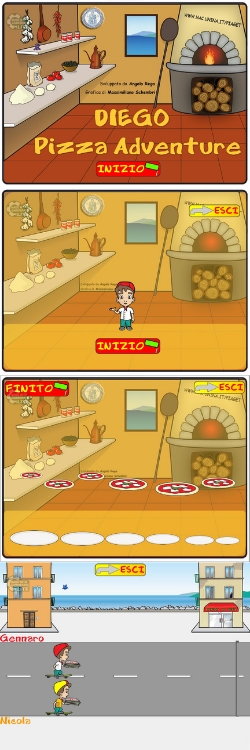
Diego Pizza Adventure – Il software “Diego Pizza Adventure” permette di divertirsi con giochi di ispirazione piagettiana (teorie sullo sviluppo del bambino dello psicologo J. Piaget) e vuole essere uno strumento per stimolare alcune capacità cognitive di bambini di età compresa tra 5 e 9 anni di età. I giochi messi in scena riguardano l’acquisizione delle relazioni spazio-temporali e del concetto di velocità; la capacità di costruire una serie, cioè l’abilita’di ordinare gli oggetti secondo una dimensione, e la capacità di creare corrispondenze fra elementi di serie diverse; aiuta a stimolare l’apprendimento del concetto di conservazione, secondo cui un liquido viene riconosciuto di quantità costante anche se e’travasato in recipienti di diverse forme e dimensioni; permette ai bambini di allenarsi con le capacità di trattare i quantificatori “tutti”e “alcuni”, applicati alle classi e alle sottoclassi di una gerarchia. E’ disponibile per windows qui: diegoadventure.exe
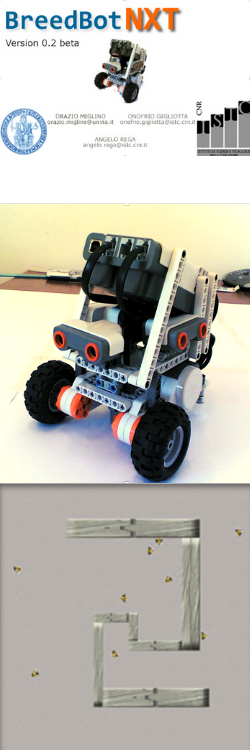
BreedBot NXT – Sviluppato da Onofrio Gigliotta – Versione per Lego NXT a mia cura. Allevare’ robot, farli riprodurre, migliorarne le caratteristiche e alla fine costruire e far funzionare il modello prescelto. Fantascienza? No, una realtà già operativa: bastano un kit Lego e un software gratuito. E’ il frutto di una attività congiunta tra Isti-Cnr e alcune università, che apre la ricerca vita artificiale ad applicazioni anche nel mercato ludico-educativo “BreedBot”, grazie ad un approccio originale e innovativo della robotica e della vita artificiale, è stato pensato anche per il nascente mercato della robotica educativa e di intrattenimento. Una ‘tentazione’ ludico-pedagogica, insomma, che potrebbe divenire irresistibile per molti bambini e adulti, soprattutto in questo periodo di regali, dato anche il costo non insormontabile (circa 240 euro il kit, circa 120 i tre sensori).

Braccio Robotico – I componenti utilizzati per la costruzione del braccio sono stati acquistati presso RobotItaly; molti dei pezzi utilizzati sono disponibili anche presso buoni negozi di modellismo) e rispondono ai requisiti di modularità, semplicità e robustezza indicati sopra. In particolare le staffe, i tubi, la viteria ed altri accessori utilizzati per la struttura del robot, e per sostenere i servo-motori, fanno parte della serie Erector Set della Lynxmotion (http://www.lynxmotion.com/). I servo-motori utilizzati sono digitali e sono prodotti dall’Hitec. Essi sono controllabili in termini di angoli desiderati, e sono in grado di ritornare l’informazione sull’avvenuta esecuzione del comando a loro impartito attraverso la stessa scheda che li controlla e che è in grado appunto di interpretare le informazioni provenienti dagli effettori elettronici..
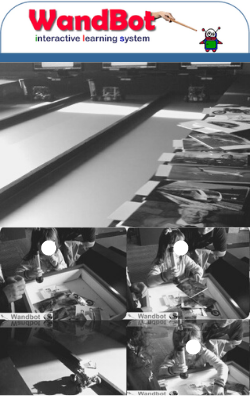
WandBot – WandBot è un sistema integrato di sensori, attuatori e software con il quale è possibile costruire degli ambienti di realtà aumentata da utilizzare per finalità ludiche, educative e riabilitative. In sostanza, WandBot consente di potenziare i consueti spazi di vita (stanza dei giochi, aule scolastiche, palestre, ecc.) con degli oggetti che se toccati e stimolati dall’utente-giocatore rispondono in vario modo (producono suoni, accendono luci, aprono scatole, attivano filmati, fanno muovere dei robot, ecc.).
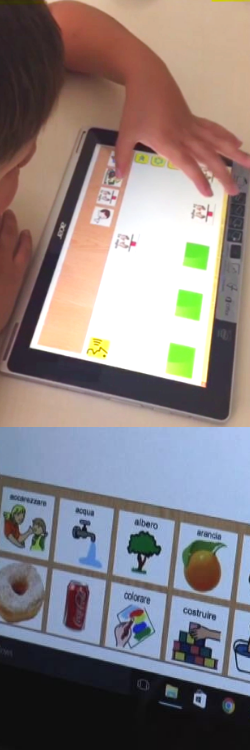
Liar Versione 1.0 – LIAR è un efficace strumento di comunicazione per persone affette da disturbo del linguaggio dovuto a patologie congenite; condizioni acquisite; condizioni neurologiche evolutive; ed esprime il massimo dell’efficacia in quelle condizioni evolutive dove l’assenza di linguaggio si accompagna a gravi disturbi di comunicazione interpersonale. È un sistema moderno per la Comunicazione Aumentativa e Alternativa (CAA) ed è sviluppato per migliorare la comunicazione nelle persone con disturbi del linguaggio e della Comunicazione Espressiva.Il software è utilizzato principalmente come un comunicatore dinamico e favorisce lo scambio di messaggi attraverso la selezione di pittogrammi con sintesi vocale in lingua italiana.
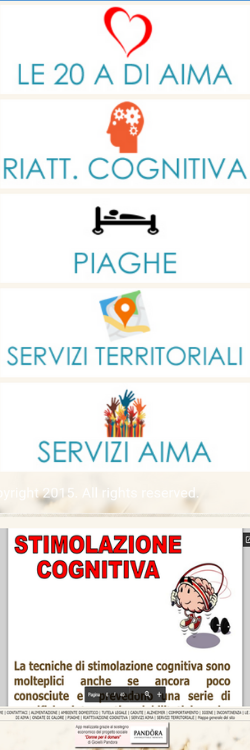
AIMA APP – Con un semplice click si potrà apprendere a contenuti redatti da personale qualificato su come gestire le emergenze, l’igiene della persona, le cadute, i comportamenti problematici, le ondate di calore, l’organizzazione dell’ambiente domestico e molto altro ancora. Oltre a queste informazioni indispensabili, sono disponibili apposite sezioni che illustrano tutti i servizi di AIMA Napoli Olus, i servizi disponibili a livello territoriale e, in più, un apposito pulsante che permette di accedere ad una pagina speciale del sito web dell’associazione così da mettere l’utente nella condizione di poter contattare un team di esperti disponibile a rispondere a richieste specifiche rispetto alla patologia dei propri cari.
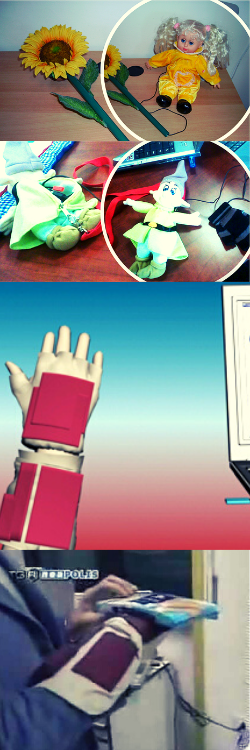
EduGlow – Un particolare guanto che abbinato ad un tappeto sensibile, permette mediante la manipolazione di oggetti specifici, la emissione di suoni che potrebbero definire localmente le proprietà dell’oggetto, fare avvenire altre modificazioni ad hoc a rispondere con un particolare stimolo quando si tocca una determinata parte del corpo. Questo guanto multisensoriale nasce con l’idea di essere uno strumento che si va ad integrare nelle pratiche riabilitative di tipo cognitivo. Tutto questo apparato serve per catalizzare l’attenzione dei pazienti nelle pratiche terapeutiche. Il sistema, sebbene ingegneristicamente sia molto semplice, lascia al terapeuta una varietà di possibilità da integrare all’interno della terapia perché si possono utilizzare tutti gli oggetti che sono presenti all’interno della stanza e che vengono “taggati” con particolari sensori”. La comunicazione è di tipo wireless senza fili basata su un comunissimo protocollo bluethoot. Tutto questo permette di utilizzare il guanto con tutti i computer tradizionali che sono dotati di periferica bluethoot o che comunque possono essere dotati attraverso delle comunissime periferiche usb che sono anche di basso costo.
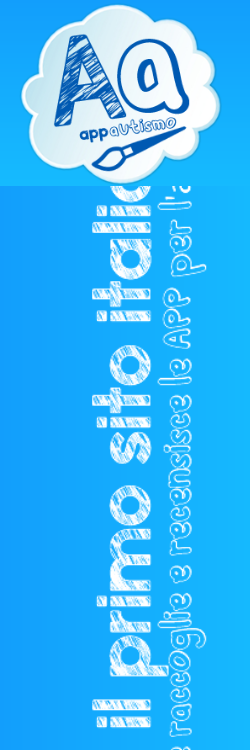
App Autismo Web Portal – http://appautismo.altervista.org/ I bambini con diagnosi di disturbo dello spettro autistico presentano difficoltà in diversi ambiti di vita, che vanno da un livello lieve ad un livello grave. Difficoltà nell’interazione sociale e nella comunicazione, comportamenti stereotipati, interessi ristretti, oltre che una lunga serie di altre complicazioni sono causa di grande disagio per chi ne soffre e per chi in generale si prende cura di loro, come genitori, terapisti e insegnanti. Nell’ultimo decennio, le tecnologie digitali come smartphone e tablet, hanno trasformato il modo in cui le persone comunicano e accedono alle informazioni. I dispositivi portatili hanno assunto un ruolo importante di ausilio e sostegno alle persone con disabilità. I ricercatori sempre più si sono accorti del potenziale della tecnologia all’interno dei percorsi terapeutici delle persone con ASD. Software per dispositivi mobili, come le app per smartphone e tablet, sono stati successivamente sviluppati e resi disponibili sul mercato per i pazienti e per le loro famiglie, e il numero è costantemente in crescita.

Training Autogeno APP – Il training autogeno si fa con Android. E’ un’applicazione che, attraverso una voce registrata ed una musica rilassante, guida l’utente in una sessione di training autogeto e, precisamente, nell’esercizio della “pesantezza”. Il Training Autogeno è una tecnica di rilassamento che consente di realizzare spontanee modificazioni psico-fisiche inducendo alla calma e ad una maggiore capacità di autodistensione. Permette una pausa profilattica ed un rapido recupero di energie.Il T.A. influenza positivamente varie funzioni dipendenti dal sistema nervoso vegetativo quali la respirazione, la circolazione del sangue, il metabolismo. Permette di attenuare lo stress, l’ansia e somatizzazioni.Occorre sottolineare che ci si riferisce alla tecnica adottata dal suo fondatore il Dr. Johannes Heinrich Schultz che la elaborò e la introdusse circa 100 anni fa in Europa.
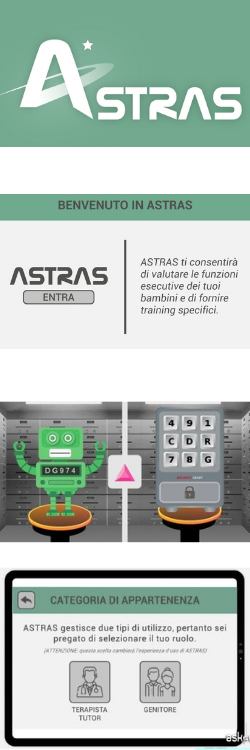
ASTRAS – mira a valutare e trattare le seguenti funzioni esecutive: attenzione, memoria di lavoro, inibizione, flessibilità cognitiva e pianificazione. Queste garantiscono un’adeguata risposta alle richieste provenienti dall’ambiente. Può essere utilizzata da tutti gli operatori (es. insegnanti, psicologi, logopedisti, neuropsichiatri infantili etc.) che lavorano con bambini con disturbi del neurosviluppo di età compresa tra i 6 e gli 11 anni. ASTRAS si compone di numerosi esercizi di training: tre per ognuna delle cinque funzioni esecutive considerate. Gli esercizi sfruttano alcuni principi di gamification per rendere il trattamento più coinvolgente e piacevole.
Trovi maggiori informazioni su: www.astras.it
Partecipazione a progetti finanziati dalle Agenzie Europee
LEARN2 LEAD
Research Area: Advanced Learning Technology
The effectiveness and efficiency of the team is an emergent property of the dynamics that develop within the team in a continuous cycle of “forming – storming- norming and performing”. Effective team leaders manage these dynamics in ways that help the team to meet its objectives. As well as technical skills related to their area of business, leaders thus require competencies in “people management”, resource management and organization. Effective training in these areas is scarce and is usually available only in high quality MBA programs or in major corporations. In this setting, the goal of Learn2Lead is to design, implement, and test a novel, online approach to training in team leadership, suitable for use in SMEs, small government offices, NGOs etc. The training provided by Learn2Lead is based on an online game. In the game, each learner manages a simulated team of employees (e.g. a team of workers in a bank agency, a post-office or a local government office) which competes against other teams to maximize its objectives (e.g. profit, volume of services delivered, customer satisfaction). L2L software will be tested in three trial sessions in France, Italy and Spain. Documentation and software will be released in English, French, Italian and Spanish. Learn2Lead is a research project, funded by the European Agency for Education, Culture and Audiovisual. Learn2Lead will last for 24 months and will involve 4 Countries in European Community and 6 partners from different field, university, consulting firm and research centers.
T3 – Teaching to Teach with Technology
Research Area: Advanced Learning Technology
In recent years, research has generated a wide range of methodologies, tools and practices for the application of technology in learning. The partners in T3 have played an active role in this work. The techniques they have proposed (and validated) in research include virtual environments (for the teaching of soft skills), simulations of biological, physical and processes (in science teaching), simulations of inter-social processes (in management training), serious gaming (again in management training), the use of Web 2.0 technology (in collaborative learning), and the use of robots (in science education for school children). Outside the laboratory, however, use of these and similar technologies remains low. Despite major investment, the majority of modern e-learning continues to be based either on video-lessons (mainly used in company or university settings) or on page-turning web sites. Against this background, the strategic goal of T3 is to develop and validate an innovative teaching program to promote the use of advanced learning technology by university teaching staff; secondary school teachers; trainers involved in VET.
SINAPSI
Research Area: Advanced Learning TechnologyThe SINAPSI Project – Simulazioni INterattive per l’APprendimento di Skill Individuali – deploy and test an innovative online tool and methodology for the teaching of “soft skills” such as negotiation, entrepreneurship, creativity, motivation, teamworking, etc. To achieve this goal, the project will bring together a 3D simulation platform, developed in an earlier Leonardo project (SISINE) by the ISTC-CNR and a classroom-based methodology for the teaching of soft skills, already field tested by one of the partners, Entropy, an Italian training company. The tools and methodology provided will be suitable for use in small and large organizations in both the public and the private sector. SINAPSI will use the specific advantages of the platform developed in SISINE and the general advantages of e-learning to surpass the usual difficulty diffused in soft skill training.
Training soft skill in Europe
Social, politic and economic changes of the lasts years in Europe like frontier’s despondency, introduction of the only money and globalization had brought to important cultural transformations that influenced also the work systems and practices. The “human factor” became to be view as an important variable on the effectiveness and efficiency of public and private organizations. The modern companies need to focus on training systems that consider both technical and personal improvement. The training of soft skills is now perceived by European organizations as a way of improving overall effectiveness and efficiency as well as the performance of individual worker. Today, however, effective training in soft skills is still relatively rare. There are many reasons. Some of the most important are the limitations and high cost of traditional teaching methods, which mainly target small groups of managers. Another factor is the inability of small companies to make the required investment. Cultural and economic factors also play a role: even today, managers in some European countries are less aware than others of the advantages to be gained from effective training in soft skills.
EUTOPIA-mt
Research Area: Advanced Learning TechnologyEurope is the theatre for a growing number of intercommunity conflicts. In recent years these have included not only “historical conflicts” – such as those in N. Ireland, Cyprus, the Balkans, and the Basque Country – but also new conflicts related to poor integration of immigrant population and new immigration from the developing countries. In this situation a steadily growing number of professionals – local administrators, policemen, teachers etc. – come into contact with inter-community conflict in their daily work. In many cases they lack the skills to perform their work effectively. The last twenty years have seen the development of best practices for teaching and developing such skills. However, very few of the potential beneficiaries have access to this kind of training. The main reason is that nearly all current training is provided in the classroom – at a high cost, particularly for the organizations (usually NGOs) providing the training. In this setting, the goal of EUTOPIA-MT is to use technology to make mediation training available to far larger populations than is currently possible. To this end, the project will bring together two existing products: (i) an innovative methodology for the teaching of mediation skills, based on role-playing in the classroom; (ii) a Web-based simulation tool (EUTOPIA) allowing teachers to provide use the same techniques with online learners. The project will test the effectiveness of this solution in three situations of intercommunity conflict, respectively in Cyprus, Northern Ireland and Southern Italy (where the conflict involves friction between native and immigrant communities). In all three keys teachers, from NGOs already providing mediation training to local communities will test the effectiveness of the technology solution in bringing their services to a broader target population. The project is expected to have a double impact. The immediate effect will be to create a body of teachers and trainers with the ability to use innovative technology in the teaching of mediation skills. The larger and more important effect will be to make this kind of teaching available to much larger populations than is currently possible. Given the political and social impact of inter-community conflict this is an extremely important goal.
DREAD-ED
Research Area: Advanced Learning TechnologyNowhere in the world is immune from disasters, the key to reducing mortality and damage is advance planning. Those at risk need to learn how to react to specific events (e.g. earthquakes) and to do this they also need soft skills: communication and understanding of information under conditions of stress, problem-solving with partial or contradictory information, decision-making in the face of competing demands. DREAD-ED’s proposes an innovative, technology-based teaching methodology to meet these needs. The proposed methodology will provide cost-effective training and is based on the concept of experiential learning: to acquire new competences, learners should be placed in situations where they can experiment under safe conditions. To this end, the project will adopt a blended strategy in which classroom teaching is complemented by tutor-supervised role-playing in a PC-based, online Virtual Environment, accessible from their homes and offices. Within the virtual environment, learners from different backgrounds will cooperate to simulate group interactions and individual decision-making during a disaster.
SISINE
Research Area: Advanced Learning TechnologyThe SISINE Project will last for 24 months and will include 9 WPs (see Table 1). The project has been developed to achieve 3 goals:
- The development of innovative training practices for the teaching of Negotiation, leading to the development of new teaching and evaluation methodologies.
- The creation of software based on Artificial Life and the Massive Multiplayer Online Role Playing Games (MMORPG), which is both useful and usable and which helps the trainee to acquire negotiating skills;
- The development of an accessible, self-sustaining exploitation model which is suitable for widespread application in the countries involved in the pilot trials and elsewhere in Europe.
General Outline The main aim of the SISINE Project is to provide a Best Practice regarding negotiation. This practice would allow trainees to acquire negotiation skills through the use of technological simulation tools. It would be based on a Training Kit composed of a software application, a trainer’s manual (which would describe the methodology concerned) and a user’s guide.However, the development of a “Best Practice” requires time. It is necessary to take into account how specific that which is being taught is, end user characteristics and the different training methods used in different countries. Finally, a “Best Practice” cannot be considered as such if it has not been evaluated with trainees. In line with these needs, the SISINE Project applies an iterative methodology in which the initial technological and methodological assumptions regarding which methodology and technology to adopt will be verified through two cycles of:
- user testing;
- collection and analysis of feedback;
- revision of the Kit.
WANDBOT
Research Area: Advanced Learning TechnologyWandbot is a game that through the use of pervasive technologies aimed at encouraging the development of new recreational scenarios where the user refines simultaneously cognitive, motor and social skills. The game consists of a unusual race of robots because the winner robot is declared by the actions that player performs in the real world.
BLOCK MAGIC
Research Area: Advanced Learning TechnologyBLOCK MAGIC is centered on the concept of a magic block – an “intelligent” version of the “logical blocks” and “teaching tiles” already familiar to teachers. When children touch a block, or a sequence of blocks with a wand or a glove, BLOCK MAGIC generates feedback (e.g. by talking) that changes from one activity to the next or at different stages in the same activity. This feature makes the system an endless source of surprise and curiosity.
BLOCK MAGIC combines low cost RFID technology, “scripts” for learning activities, and a software engine controlling block behavior. In a typical scenario, the class is divided into groups and provided with a bag of Magic Blocks. The teacher sets a task (e.g. order the magic blocks to tell a story) designed to develop a specific creative, logical, linguistic, or strategic skill. The children then work together to solve the task.
BLOCK MAGIC will (i) define a methodology and a large set of learning activities based on Magic Blocks (ii) design and implement the Magic Blocks; (iii) collaborate with teachers to test and refine the design; (iv) test the final system in infant and primary schools in Italy, Greece, Spain and in Germany; (v) encourage take-up in schools and countries not involved in the project.
